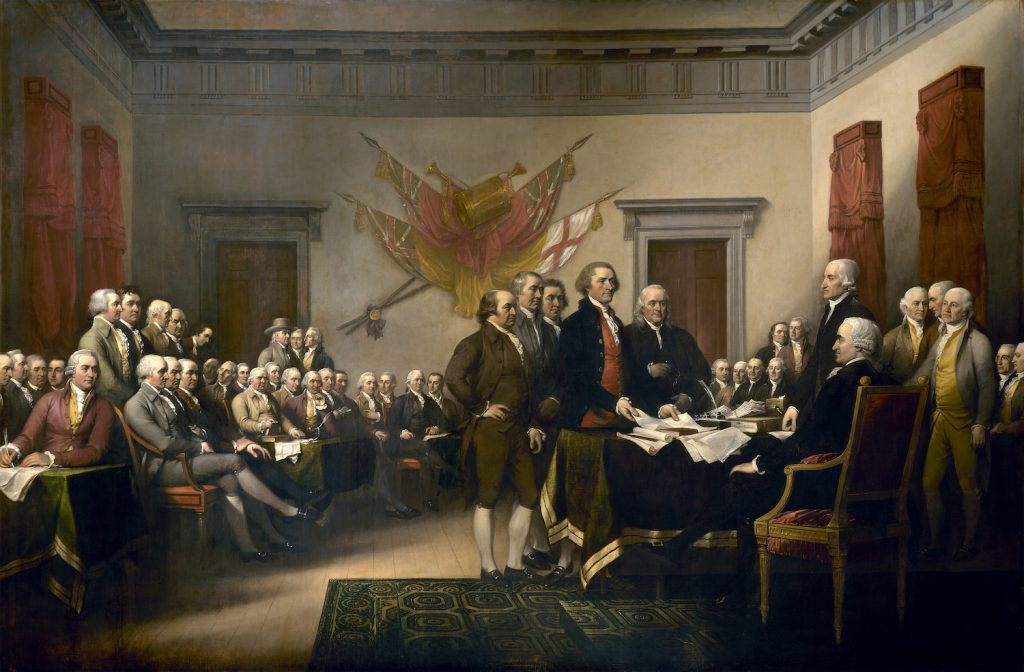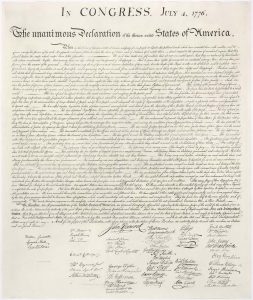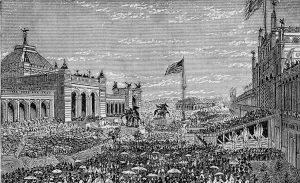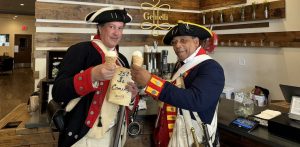Brandywine Stories: Dare to Declare
Celebrating independence

Huzzzzzahhhh! On July 4, we celebrate Independence Day. For most of us that means a long weekend at the shore or in the Poconos with baseball, hot dogs, apple pie and fireworks displays, both large and small.
But why? And how have our Independence Day celebrations changed over the decades?
1776: The Beginning

On July 4, 1776, at the Pennsylvania State House in Philadelphia, our Founding Fathers unanimously approved the edited Declaration of Independence to boldly clarify our position to King George of England.
This historic document was authored by the Committee of Five, which started their work on June 11 with heated discussions, arguments and revisions until concluding on July 3. Colonists — patriots and loyalists alike — read it with great excitement, concern, hope and fear at street corners, churches and taverns. The now-famous second paragraph declares: “We hold these truths to be self-evident, that all men are created equal, that they are endowed by their Creator with certain unalienable Rights, that among these are Life, Liberty, and the pursuit of Happiness—”
The prior day, July 3, John Adams (who later became our second president) predicted in a letter to his wife Abigail that this momentous occasion “would be celebrated by succeeding generations … as the day of deliverance … with pomp and parade, with shows, games, sports, guns, bells, bonfires and illuminations from one end of this continent to the other from this time forward forevermore.”
1826: Jubilee—50th Anniversary
Our nation’s sixth president, John Quincy Adams, celebrated by watching a parade headed toward the Capitol from the White House steps, accompanied by Vice President John Calhoun. Adams later enjoyed dinner and fireworks as local celebrations involved religious services, public speeches and parades.
July 4, 1826 is also remembered for the deaths of our second and third presidents, John Adams and Thomas Jefferson, who both died on that momentous date. Of Adams — who remarked shortly before his passing, “It is a great day. It is a good day.” — the official War Department announcement noted: “With a prophetic eye he looked through the impending difficulties of the Revolution and foretold with what demonstrations of joy the anniversary of the birth of American freedom would be hailed.” And of Jefferson: “The Declaration [of Independence] of which, emanating from his mind, at once proclaimed the birth of a free nation and offered motives of hope and consolation to the whole family of man.”
Since then, every 50 years, Congress has authorized a federal commission with instructions to hold events in Philadelphia, where the Declaration of Independence was signed.
1876: Centennial—100th Anniversary

U.S. Representative Daniel Morrell of Pennsylvania called for “an imposing recognition of the nation’s progress during the first century of its existence.” The Centennial Exhibition in Philadelphia’s Fairmount Park was also the first official World’s Fair hosted by the U.S. Over 200 buildings were constructed for it, surrounded by a nearly three-mile fence. Philadelphia also hosted the Sesquicentennial Exhibition in 1926, spearheaded by John Wanamaker (founder of Wanamaker’s department store).
Our 18th president, Ulysses S. Grant, transmitted to Congress his wishes “to display to the world the growth and progress of a nation devoted to freedom and to the pursuit of fame, fortune, and honors by the lowest citizen as well as the highest.” The World’s Fair attracted nearly 10 million visitors in its six months of operation, showcasing the nation’s scientific, cultural and artistic achievements.
1926: Sesquicentennial—150th Anniversary
Under the leadership of our 30th president, Calvin Coolidge, the national commission promoted an eight-day themed celebration with a series of events: Patriot’s Pledge of Faith Day on June 28; Universal Education Day on June 29; Founders’ Day on June 30; and Greater America Day, Signers’ Day, Monticello Day, Jefferson Centennial Day and Sesquicentennial Independence Day on July 1 through 5.
1976: Bicentennial—200th Anniversary
Under our 38th president, Gerald Ford, the bicentennial “Festival of Freedom” was declared to “vitalize the ideals for which the Revolution was fought; a spirit which unites the nation in purpose and in dedication to the advancement of human welfare as it moves into its third century.”
Three key themes for this celebration included: Heritage ’76, which recalled our heritage and its historical perspective as we reexamined our origins, our values and the meaning of America — to take pride in our accomplishments; Open House USA, which promoted travel to programs and events, encouraging citizens to expand their knowledge of our country and extend a particular welcome to visitors; and Horizons ’76, which challenged every American to undertake at least one project which manifests the pride, the priorities and the hopes of their community — to pool resources and talents in a constructive effort to demonstrate concern for human welfare, happiness and freedom.
On the Fourth of July 2025, when you fire up the barbecue, take a moment to remember that our Declaration of Independence was more than an assertion of political independence. It kindled a revolution in peoples’ hearts and minds that continues to this day.
2026: Semiquincentennial—250th Anniversary
 What’s ahead for our next milestone celebration of independence? National, state, regional and local America250 Commissions abound. In our backyard, the America250 PA Chester County Commission aims to “inspire and engage all our communities in commemoration of America’s founding, connecting Chester County’s stories to the nation’s past, present, and future.”
What’s ahead for our next milestone celebration of independence? National, state, regional and local America250 Commissions abound. In our backyard, the America250 PA Chester County Commission aims to “inspire and engage all our communities in commemoration of America’s founding, connecting Chester County’s stories to the nation’s past, present, and future.”
Through 2026, the Commission urges all to hold interactive, inclusive, compelling experiences that showcase the many ways Chester County participated in and influenced our nation’s past and elevate our understanding of our continuing journey to build a more perfect union: Life, Liberty and the Pursuit of Happiness for all.
Chester County is sacred ground: decisive military actions here during the Philadelphia Campaign led to our nation’s victory, and our freedom was literally forged by our iron and steel production. Chester County was a proving ground for the “unfinished business” of the Declaration of Independence — where diverse social values influenced the end of enslavement and the beginnings of women’s suffrage, civil rights and more —and continues to shape our communities today. Huzzah!
 The Brandywine Stories series raises awareness of Chester County’s role in our nation’s fight for freedom, building engagement for 2026, the 250th anniversary of the Declaration of Independence. Based on Congressional Research Service reports. For Friends of America250 PA Chester County. A250Friends.org.
The Brandywine Stories series raises awareness of Chester County’s role in our nation’s fight for freedom, building engagement for 2026, the 250th anniversary of the Declaration of Independence. Based on Congressional Research Service reports. For Friends of America250 PA Chester County. A250Friends.org.
